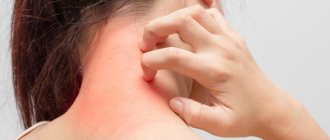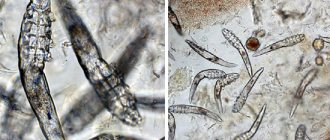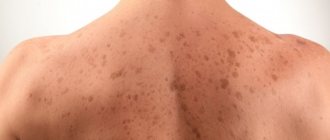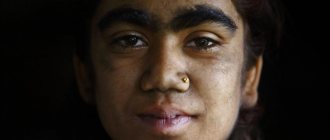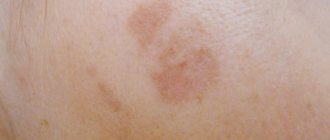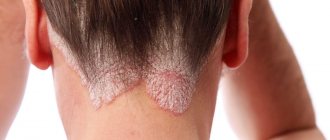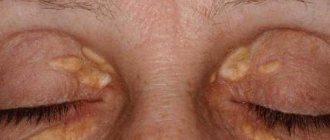Perioral dermatitis is a long-term skin disease and can have several names (rosacea-like, steroidal or perioral dermatitis). The disease is most often observed in women, due to the frequent use of cosmetics, and in some cases, dermatitis can also occur in a child.
Perioral dermatitis can be provoked by any cosmetic cream and medications that contain corticosteroids that can destroy the structure of collagen and elastin with simultaneous damage to the vascular system. This action can lead to erythema, microtears of the epidermis and telangiectasia (dilation of small skin vessels).
The disease is characterized by the appearance of small hyperemic papules that can merge into a large plaque. In the case when the inflammatory process is accompanied by granulomas, as a rule, oral granulomatous dermatitis develops, which is often observed in children.
Oral dermatitis - what is it and what does it look like?
According to the international classification (ICD-10), the disease is assigned code L71.0. In addition to those already mentioned, it has other names: steroid dermatitis of the face, perioral dermatitis, perioral rosacea.
According to medical statistics, it affects 1 percent of the population - mostly young women and (rarely) children and men under 45 years of age.
Rosacea-like dermatitis is considered a chronic disease that affects the skin of the face around the mouth and eyes. It is characterized by rashes in the form of small reddish papules.
Appearing around the mouth, on the chin at first in small quantities, pimples increase in size and occupy more and more spaces, sometimes merging into a solid plaque and creating not only physical, but also enormous psychological discomfort for the patient.
In its symptoms, the disease resembles Broca's pigmented perioral dermatosis, in which brownish spots form around the mouth and on the chin.
The disease is often associated with stomach and intestinal problems, and again, almost only women suffer from it.
general information
Perioral dermatitis (PD) is a chronic papular-pustular inflammation of the face that is more common in women and children. Although the name suggests an eczematous disorder, it is clinically similar to acne or rosacea-like rash , with or without features of mild eczema.
The mechanism of the onset and development of the disease has not yet been studied, since there are both internal and external factors. Many causes of perioral dermatitis have been proposed, ranging from exposure to topical corticosteroids to fluoride in water or toothpaste, but the etiology (cause) remains unknown.
Despite its name, perioral dermatitis is not a true dermatitis . It primarily affects women of childbearing age and children, and the rash usually begins in the nasolabial folds and spreads perioralally, avoiding the area around the vermilion lips (i.e., lip contour). It may also spread to the eyes or forehead level.
Diagnosis is made primarily clinically, depending on the appearance of the rash . Perioral dermatitis differs from acne in the absence of comedones. A biopsy is usually not required as there are several additional diagnostic tests that can draw attention to the risk factors associated with the trigger as well as the frequent recurrence of perioral dermatitis (microscopic examination for Demodex, gastric acid testing, positive testing for Helicobacter pylori) .
The first step in improving PD is prevention by addressing risk factors. The condition may improve after a few weeks. Although perioral dermatitis can be resolved in time after discontinuation of topical corticosteroids and elimination of local irritants. The main therapeutic options are anti-inflammatory drugs and topical or systemic antibiotics . In severe cases, treatment may consist of topical corticosteroids, gradually reducing the frequency of use and then switching to a therapeutic class with lower effectiveness. Perioral dermatitis is an inflammatory skin disease with a chronic course and relapses.
Causes
Doctors are not always able to identify the cause of oral dermatitis with 100% accuracy. It can be both allergic and atopic in nature.
In addition to cosmetics (poor quality or individually intolerable), the culprits of the disease outbreak may be:
- hormonal drug (contraceptive pills, cream);
- fluoride toothpaste;
- aerosols that relieve asthma attacks;
- exposure to ultraviolet rays;
- climate change;
- disruptions in the functioning of the endocrine system;
- the presence of any infections or inflammations in the body;
- procedures that injure the skin using scrubs (peeling is not recommended for people predisposed to this form of dermatitis);
- problems with immunity;
- stress.
Doctors note cases where oral dermatitis was caused by the simultaneous use of “multidirectional” cosmetics (for example, moisturizing, nourishing, decorative).
And in children, skin problems began after using a pacifier in windy weather or in winter with severe frost.
In older children, as noted by Dr. Komarovsky and his colleagues, perioral dermatitis is often associated with the problem of dental caries , so a timely visit to the dentist will not only help keep your teeth healthy, but will also protect you from other unpleasant diseases.
If you are interested in what the treatment of seborrheic dermatitis of the scalp in adults and children is based on, read our article.
Instructions for using Topikrem cream for children are discussed in detail here.
A review of medicinal shampoos for seborrheic dermatitis on the head is presented here:
Factors in the development of the disease
The disease most often affects women under 30 years of age. Among men and children, this form of dermatitis is diagnosed quite rarely. Among the most common causes of perioral dermatitis are:
- use of external steroids (Hydrocortisone, Prednisolone, etc.). It is important to note that this particular reason is considered the most accurate option in the general diagnosis of the cause of negative symptoms. Dermatitis can often be caused by cosmetics; foundation is especially dangerous;
- natural factors (high humidity, sun rays, frost, wind, etc.);
- The causes of the disease may lie in the presence of bacteria and fungi that parasitize the hair follicles. In this case, the symptoms of perioral dermatitis require additional diagnostics;
- Hormonal levels are of no small importance in perioral dermatitis. Numerous observations confirm the increased appearance of the rash before menstrual syndrome.
It is important to note that a characteristic reaction of perioral dermatitis is the appearance of rashes when the hormonal cream is abruptly discontinued. Such symptoms worsen the disease, and patients again begin to use steroid creams for the skin of the face.
Symptoms of steroid (rosacea-like) dermatitis
Symptoms of perioral dermatitis resemble seborrheic dermatitis, demodicosis, and other skin diseases. Only a doctor can give an accurate diagnosis to a patient, and with the help of laboratory tests.
The rashes characteristic of the disease, if left untreated, remain on the face for several months or even years (from time to time the disease goes away and then returns again) and brings mainly psychological distress to the patient.
Here are the symptoms of perioral dermatitis:
- severe redness around the mouth;
- localization of a large number of pimples in the area of the lips, chin, nasolabial folds, less often around the eyes, on the eyelids;
- swelling;
- itching and burning sensation;
- dry skin, insufficient hydration, causing a feeling of tightness;
- sometimes - the formation of scales at the site of inflammation and accompanying peeling.
A characteristic feature is that between the lips and the area of inflammation there is always a narrow, two-millimeter strip of clean skin that has not been infected.
If you smear the affected skin with the first means that come to hand (this usually happens when the patient diagnoses himself and prescribes medications), additional symptoms appear that aggravate the situation:
- thickening, roughening of the skin;
- lumpy skin;
- painful pigmentation (by the way, removing spots is quite difficult).
Diagnostic methods
To diagnose perioral dermatitis, a bacterial culture for rosacea-like dermatitis should be performed.
Quite often, diagnostics reveal the presence of fungi of the genus Candida on the skin, causing oral candidiasis. However, to date it has not been possible to identify the specific infectious agents that cause perioral dermatitis.
Histology of the skin is not recommended due to the fact that there are no specific signs of perioral dermatitis. As a rule, there is a subacute inflammatory process and isolated areas of altered skin, which can be confused with similarly manifested skin diseases.
Treatment of perioral dermatitis on the face in children and adults
The treatment regimen for perioral dermatitis is quite complex. To cure the patient, the doctor uses many different medications and recommends dietary nutrition. Compliance with all the doctor’s instructions is the key to victory over the disease.
Medicines (ointments, creams, antibiotics)
The doctor begins treatment by canceling all hormonal drugs that the patient was using (this could be, for example, Advantan, Akriderm, Elokom).
The doctor also establishes a ban on the use of cosmetics. Washing in the traditional way is also prohibited.
If the disease is not very advanced, water can be replaced by rubbing with decoctions of medicinal herbs (sage and chamomile). In difficult situations, use special emulsions prepared on the basis of oil.
Medicines usually include a cream, ointment or gel, the main active ingredients of which are Metronidazole (Trichopol) and Erythromycin (erythromycin ointment is a proven drug, known to many patients, and has a reputation as one of the safest antibiotics).
Here is a list of medications used:
- Tetracycline is an antibiotic prescribed for severe forms of dermatitis;
- Tetracycline ointment – with an active antimicrobial effect;
- Unidox Solutab is an antibiotic of the tetracycline group, used to treat skin infections;
- Azithromycin is an antibiotic used to treat skin infections;
- Polysorb – as an absorbent;
- Cynovit – as an antifungal agent;
- Protopic - successfully relieves inflammation, however, the drug should not be used by breastfeeding and pregnant women due to possible side effects;
- Skinoren, Azelik - prescribed for intolerance to Metronidazole;
- Skin cap and other products containing zinc (among the most popular are zinc mash, zinc ointment) dry the skin well and can relieve itching;
- Elidel – relieves inflammation, can be successfully combined with other drugs used in complex therapy, and is approved for children from three months of age;
- Radevit ointment – effective for epithelial regeneration;
- Rozamet is a soft and at the same time effective preparation that, if necessary, can be used as a base for makeup;
- Metrogyl gel – has an antibacterial effect;
- Isotrethionine – with a similar effect to Metrogyl;
- Retinoic ointment (with isotretinoin as the main component) - helps in tissue regeneration;
- Yam ointment – stops the inflammatory process;
- Bepanten – improves the regeneration of damaged skin.
At the final stage of treatment of perioral dermatitis, various physiotherapy procedures are actively used. Cryomassage using liquid nitrogen or snow is considered an effective remedy.
If necessary, the doctor prescribes sedative medications.
Vitamin therapy is mandatory, especially for children. Thanks to it, the protective functions of the body as a whole and specifically the skin are increased.
But you need to be careful with microelements; some of them (they are called “reactogenic”) sometimes worsen the condition of the skin.
In this regard, doctors limit the intake of iron and copper in certain medications for patients with dermatitis.
Help from folk remedies
Many patients are helped by folk remedies. True, here you need to choose “your” option, since the effectiveness in each case depends on the characteristics of the skin of a particular person.
What we can recommend:
- lotion made from flaxseed oil, honey and onion juice (prepared in a water bath);
- lotions from oak bark decoction;
- infusion of birch buds (taken orally, a teaspoon of plant material is required per glass of water);
- infusion of walnut leaves (prepared in a thermos, used as lotions);
- pumpkin masks (grated and applied to inflamed skin);
- infusion of sorrel leaves (take 4 times a day, half a glass).
Diet
The diet for a patient with dermatitis should include foods rich in protein and calcium. Be sure to drink plenty of fluids.
For first courses, give preference to vegetable soups, fish soup, and cook lean borscht. There must be fermented milk products, cereals, fruits, and vegetables on the table.
Here's what one day's menu might look like:
- Breakfast: fish with corn porridge, steamed (for example, in a slow cooker), tea.
- Lunch: cream soup of fresh zucchini, salad of leafy vegetables, buckwheat porridge, dried fruit compote.
- Afternoon snack: kefir, cheese and a slice of dried bread.
- Dinner: cottage cheese seasoned with low-fat sour cream, tea.
The main symptoms and signs, possible causes, as well as photos of neurodermatitis in adults can be found in this publication.
If you want to find out which cheaper analogues of Emolium cream are offered by pharmacy chains, read this material.
Traditional methods of treatment and normalization of the general condition of the body
You can start treating the disease using traditional medicine only after consulting a doctor. This method is an addition to the main treatment. The most commonly used recipes are:
- Symptoms of the acute stage of the disease are relieved with lotions. Decoctions prepared from string, chamomile and calendula flowers, and plantain leaves are used. The medication is applied to the damaged area. The lotions are changed three times a day.
- Linseed oil. The product is used as a compress. It is prepared like this: 50 grams of honey and the same amount of oil are heated until a homogeneous consistency is obtained. After this, 25 grams of onion juice is added. The resulting composition is applied to a napkin and applied to the affected area.
- It is recommended to frequently moisten the damaged area of skin with dermatitis with water from thermal springs.
Traditional medicine for internal use.
- You can not only drink a decoction of birch buds, but also lubricate inflamed areas with it.
Remission will occur only when not only the external symptoms of the disease are eliminated, but also internal diseases. It is necessary to put the endocrine and nervous systems in order and improve the functioning of the gastrointestinal tract. To maintain the body and improve its protective functions, vitamin complexes, medications and folic acid are prescribed.
In sunny weather, it is mandatory to apply anti-tanning products; it is advisable to avoid visiting the beach.
How to cure disease in women during pregnancy and lactation
When the disease worsens, women who are breastfeeding are concerned about the question: is this type of dermatitis contagious or not, is it transmitted by airborne droplets, and what should be done to prevent the baby from having problems similar to the mother’s.
In fact, there is no danger of infection, doctors assure. However, a predisposition to such a disease can be transmitted at the genetic level, and nothing can be done about it.
The only thing a woman needs to do in this situation is to take care of the child’s hygiene, teach him to do this on his own in the future, and to use detergents and cosmetics correctly.
In pregnant women, perioral dermatitis sometimes appears at the beginning of pregnancy , this is due to physiological changes in the body and weakened immunity.
Drug therapy for expectant mothers must be selected by a doctor, since many drugs that a woman has successfully used before are contraindicated in her new condition.
By the way, even such a harmless product, in the opinion of many women, as boric acid cannot be used either during pregnancy or while breastfeeding - it is quickly absorbed from the surface of the skin into the depths, enters the blood and can negatively affect the developing fetus.
Forecast and preventive measures
It may take several weeks or even months for oral dermatitis to completely heal. It is possible that in the future, after using steroids or low-quality cosmetics, the rash will appear again. It is important that the use of any ointments for perioral dermatitis should be done with great caution, especially in patients prone to allergic reactions.
To prevent rashes, it is recommended:
- rejection of bad habits. Smoking and alcohol abuse weaken the body, resulting in reduced immune defense;
- use of cosmetics recommended for patients with atopic or contact dermatitis;
- Do not injure the skin during cosmetic procedures. Exacerbation may be caused by scrubbing, peeling, or using certain face masks;
- You should choose your toothpastes carefully. Patients who have had episodes of perioral dermatitis should avoid pastes containing fluoride;
- It is important to take multivitamin preparations that help strengthen the immune system. It is advisable to choose products that contain B vitamins and vitamin E. These vitamins improve the condition of the skin and promote the rapid restoration of areas damaged by dermatitis.
Prevention of skin diseases
If there is a risk of developing oral dermatitis, it is better to spend a little time and effort on prevention than to then deal with treatment, heroically overcoming physical and moral inconvenience.
What to do:
- follow a diet (nothing salty or spicy, no alcohol);
- do not use corticosteroid creams and ointments (choose analogues that are safe for yourself);
- choose soaps and shampoos without “chemicals”, for example, tar soap;
- do not violate hygiene rules;
- use high-quality, hypoallergenic cosmetics that protect the skin from ultraviolet rays;
- brush your teeth with toothpastes that do not contain fluoride.
Development of the disease in childhood
It must be borne in mind that perioral dermatitis in a small child may be slightly different. Papules are pale pink or yellowish-brown and to clarify the diagnosis, especially when irritation occurs on the face, bacteriological culture and scraping of the contents of the papules that caused steroid ointments or cream are required. After determining the cause, the therapeutic measures recommended by the doctor are carried out.
In a child, negative manifestations (in the photo) most often develop when using a spray or inhaler. As a rule, such products contain hormones. Acute symptoms of perioral dermatitis occur only after discontinuation of the steroid medication.
Most often, rosacea-like dermatitis in children is painless, although sometimes there may be a burning sensation at the site of the rash. In addition, rashes in the eye area are sometimes possible in children, which requires caution during treatment.
Experts classify oral dermatitis in childhood as one of the types of rosacea, since rosacea-like dermatitis is most often observed in young children. Perioral dermatitis in a small child, as a rule, does not pose a threat to health, but in the absence of adequate treatment it can cause inconvenience to the baby.
Reviews
Asya G.: “I recently went to a forum where various skin diseases are discussed. For some, Triderm and sulfur ointment help, for others, homeopathy, and one young lady recommended Darsonval, a device for physiotherapy that can be done at home. I got excited and consulted with my doctor. She believes that it is possible to try, but there is one “but” - the device cannot be used during an exacerbation of the disease. In general, he says, Darsonval really helped a lot of people.”
Lydia P.: “I had an exacerbation of perioral dermatitis during pregnancy. Previously, I used Clindovit gel, but it is not highly recommended for expectant mothers, so, after consulting with a doctor, I bought Bioderma cream, Skin-cap and regular Baby cream. I won’t say that it helped perfectly, but at least the process was stopped.”
Timofey N.: “I managed to get sick with something that happens very rarely in men - flight attendant disease. The doctor prescribed antibiotics, in addition to them, allergy medications. My wife learned from friends that it is good to wipe the skin with a solution of boric acid and onions and drink a decoction of birch buds. Yes, I also treated my skin with lotion, which my wife prepared from aloe juice, castor and eucalyptus oil. Believe it or not, after a week I, one might say, recovered.”
Treatment
Therapy is prescribed by a specialist; usually the choice of drugs for treatment is made taking into account the individual characteristics of the disease. The duration of the course varies from 2-3 weeks to 2-3 months and depends on many factors, including the stage of the disease at which professional medical help was sought.
In some cases, for example, when climate conditions change, multiple relapses may occur, therefore, after completion of treatment, a course of preventive measures is required to maintain the achieved positive result.
The main methods of getting rid of perioral dermatitis that are practiced today are discussed in detail below in the relevant chapters.
Zero therapy
“Zero therapy” is understood as one of the first stages of treatment, which implies the following conditions must be met:
- Buying and using toothpaste that does not contain fluoride.
- Stop taking a course of corticosteroid treatment if it was practiced before.
- Refusal to use decorative cosmetics on affected areas of the face.
- Using special products for washing that do not cause an allergic reaction even if you are not prone to it.
- Compliance with a special dietary complex.
If you follow the indicated rules, positive dynamics will be observed in just a week. The structure of the skin will begin to gradually recover, the body will launch natural regeneration processes, in addition, inflammation will be relieved and new rashes will stop occurring.
When treating severe forms of perioral dermatitis, the following side effects may occur:
- The appearance of red spots on the skin.
- The appearance of additional swelling.
- Local increase in temperature in the lesions.
Many people are alarmed by these symptoms and change their course of treatment at their own discretion, starting with stronger medications or resuming the use of corticosteroids. This can only worsen the situation and make the recovery process even longer.
You might be interested! How to cure seborrheic dermatitis at home?
In fact, all the symptoms described are absolutely normal reactions on the part of the body and they will soon disappear naturally.
Question answer
How to prevent the occurrence of oral dermatitis?
Since there are many causes of the disease, and the exact cause has not been established, in this case it is best to follow the general rules:
- Do not use hormonal ointments unless prescribed by a dermatologist.
- Avoid regularly using heavy cosmetics (foundation, powder).
- Moisturize your skin with Vaseline, it does not clog pores (you can use pure Vaseline, or you can combine 2 tsp of the product with 3 tsp of aloe leaf juice).
- Wash your face with mild cosmetics (Dove Gentle Exfoliation Cream Soap).
- Sunlight and wind can aggravate perioral dermatitis. Be sure to protect your skin if you will be out in the sun for long periods of time.
How to treat perioral rash during pregnancy?
Treatment of oral dermatitis in pregnant women occurs according to the following scheme:
- Avoid cosmetics completely.
- Wash your face daily with cool water (wipe with ice cubes).
- Use a decoction of celandine or chamomile to wipe the skin (preparation: 1 tablespoon of dry herb, steam with 0.5 tablespoons of boiling water, strain after 15 minutes).
- Moisturize your skin with hypoallergenic baby cream "Bepantol Baby".
- Don't use fluoridated toothpaste.
- At night, treat sore skin with zinc ointment. In the second semester of pregnancy, Metrogyl is allowed.
- Medical supervision is required.
What vitamins should you take for oral dematitis?
Almost all skin diseases are treated comprehensively. The doctor creates a treatment regimen that necessarily contains vitamins. Particularly important for PD are B vitamins, these are pyridoxine, nicotinic acid and riboflavin (they participate in metabolic processes and strengthen the immune system).
Do patients with oral dermatitis need a diet?
Needed. Food must be vegetarian and hypoallergenic. Therefore, eggs, meat products, spicy, fried, smoked, too salty dishes, coffee, chocolate, fresh bread, and baked goods are excluded from the patient’s menu. The diet should contain only dairy, vegetable and cereal products (porridge and soups, crackers), as well as fresh fruits. Low-fat fish varieties. Herbal tea, plain water, kefir.
Is it possible to get rid of perioral rash forever?
As medical practice shows, this form of skin disease is almost never completely cured. The disease can last for decades. Its symptoms either completely disappear or reappear under the influence of external factors (wind, sun, allergies to cosmetics, etc.).
Diet
Patients diagnosed with perioral rosacea are strongly advised to follow a diet that excludes allergenic foods.
In the acute period of the disease, preference should be given to the following products:
- kefir, fermented baked milk, yogurt and other fermented milk products. Yogurts should be consumed natural, without dyes or preservatives;
- porridge cooked in water with a little salt;
- grain bread;
- lean meat (chicken breast, turkey, etc.).
It is recommended to boil or steam food.
Strong coffee and tea, alcoholic drinks, smoked and canned foods, as well as foods rich in carbohydrates are excluded from the diet. It is advisable to reduce the amount of salt consumed. Fruits and vegetables can be introduced into the diet with caution. You should not eat exotic fruits, which are strong allergens, and you should also avoid citrus fruits.
Sometimes, to get rid of the disease, you have to completely change your lifestyle: if a person has perioral dermatitis, reviews say that the most effective treatment method is a combination of taking antihistamines and a gentle diet.
Pharmacy products
To treat oral dermatitis (photo of its manifestations above), topical medications can be used. Such means are antibacterial ointments. They not only allow you to quickly relieve the symptoms of dermatitis, but also have a positive effect with an integrated approach. Glucocorticoid hormones can be added to such drugs in order to give the drugs anti-inflammatory properties. Such ointments may even contain antibiotics. Before using such ointments, you should consult a doctor.
Listed below are ointments for the face for the treatment of oral dermatitis (photos of some drugs below).
- "Laticort". Consists of the active ingredient hydrocortisone butyrate. This drug is a glucocorticoid drug that is used externally.
- "Pimafukort". Consists of the active ingredients hydrocortisone, natamycin, neomycin. A combined drug with antimicrobial, antifungal and local anti-inflammatory effects.
- "Cortomycetin". Consists of the active ingredients hydrocortisone and chloramphenicol. A combined drug with anti-inflammatory, antiallergic and antimicrobial effects.
- "Gyoksizon", "Oxycort". They consist of the active ingredients hydrocortisone and oxytetracycline. A combined drug with antibacterial and anti-inflammatory effects.
- "Dermovate", "Powercourt cream". They consist of the active ingredient clobetasol. This drug stands out among others for its very powerful effect. It is used only in severe cases.
If oral dermatitis is accompanied by another skin disease and the affected area is large, then antihistamines in the form of tablets are used for complex treatment. Their action is aimed at a general anti-inflammatory effect on the body. The following antihistamines are used to treat oral dermatitis on the face (the photo of the manifestations of the disease was above):
- "Diphenhydramine";
- "Diazolin";
- "Suprastin";
- "Tavegil";
- "Fenkarol".
Corticosteroids are also prescribed in tablet form. These drugs are prescribed if dermatitis is not only on the face, but also on other parts of the body. The effect of this drug is similar to hormone therapy. Such drugs have a pronounced anti-inflammatory effect. Such drugs for the treatment of oral dermatitis include:
- "Prednisol";
- "Flumetasone";
- "Dexamethasone";
- "Triamcinolone".
If the cause of the development of dermatitis was the influence of one’s own immunity, then immunosuppressants should be used, the action of which is aimed at suppressing one’s own immunity.
